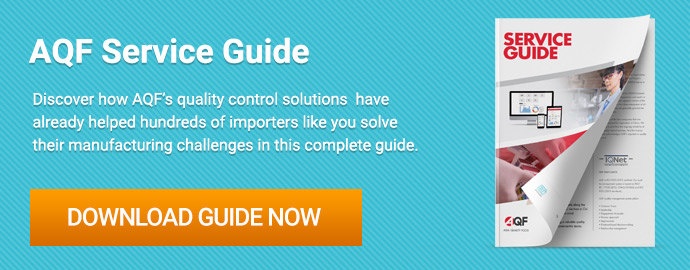 Is your supplier hiring workers that are younger than the legally required minimum working age? Are workers working longer overtime hours than legally allowed? Is your supplier providing social insurance and other benefits mandated by law to their staff?
Is your supplier hiring workers that are younger than the legally required minimum working age? Are workers working longer overtime hours than legally allowed? Is your supplier providing social insurance and other benefits mandated by law to their staff?
If you’re like many importers, you probably can’t answer any of these questions yourself. And you might not understand why these questions are important to the success of your importing business. But social compliance violations can easily cause you to lose major customers and distributors for your product.
A social audit is one of the best ways to cost-effectively evaluate your supplier and proactively identify any compliance issues. Many different social compliance standards exist, but Social Accountability 8000 (SA8000) is a good starting point for importers that are new to compliance.
SA8000 compliance sets a strong foundation for compliance with local laws and international human rights norms. By understanding the requirements of a SA8000 social compliance audit checklist, you can prepare your supplier for an audit and be able to accurately interpret the results of an audit.
Why use SA8000 as your social audit framework?
It’s ultimately up to you as the importer to choose which social audit framework to apply to your supplier depending on your own needs and customers’ requirements. But many auditing companies recommend an audit based on the SA8000 standard for its relative simplicity and clearly outlined requirements.
SA8000 is a voluntary standard for social compliance based on the UN Declaration of Human Rights, national labor laws and international human rights norms.
Many major retailers now accept international third-party audit frameworks like SA8000, rather than requiring suppliers to apply their own customized framework. Both Walmart and Disney accept SA8000 audit results for their social compliance programs, for instance.
Every SA8000 social compliance audit checklist should include the nine requirements below. And a third-party audit based on SA8000 should demonstrate the supplier’s compliance according to these requirements.
1. Child labor
Most any social compliance audit checklist, including one for SA8000, should include checks for violations involving child labor. Child labor is still a common problem in Asia. A 2019 report from Verisk Maplecroft ranked both India and China as high-risk regions for child labor.
for SA8000, should include checks for violations involving child labor. Child labor is still a common problem in Asia. A 2019 report from Verisk Maplecroft ranked both India and China as high-risk regions for child labor.
Under SA8000, child labor is considered any work performed by a child younger than 15 years old, unless the minimum age for work is higher by local law. The standard also sets requirements for the employment of “young workers” who are younger than 18 but older than 15 years old as specified above. Many countries, including China, allow for employing young workers.
A supplier will generally meet the requirements of this section if they adhere to local and national labor laws. Besides age restrictions, the standard requires that:
- Young workers only work outside of school hours if they’re subject to compulsory education laws
- Young workers do not work more than eight hours per day or work during night hours; and
- Children and young workers are not subject to unsafe working conditions

2. Forced labor
SA8000 forbids suppliers from employing forced or slave labor, as well as withholding personal documents, salary or benefits from workers. Withholding workers’ documents could make it difficult for workers to leave at will.
SA8000 requires that staff have the right to leave the workplace at the end of each workday and the right to terminate their employment with reasonable notice.
Forced labor is an important aspect of social compliance that has been banned through some specific legislature outside of voluntary standards. The U.S. banned all imports made with forced labor in 2016 and granted customs authorities the right to seize suspect shipments at the border.
3. Health and safety
A supplier is required to provide a safe and healthy workplace environment for workers under the SA8000 standard. This section has many areas in common with the U.S. Occupational Safety & Health Act of 1970.
Health and safety violations can have serious consequences beyond SA8000 noncompliance (related: Social Compliance for Garment Factories: How to Avoid Disasters). Safety violations can lead to a factory explosion or building collapse in extreme cases, delaying production indefinitely and potentially forcing you to find an alternate supplier for your goods.
A social compliance audit checklist will typically dedicate a large portion of the audit plan to checking health and safety requirements. Under the SA8000 standard, your supplier must:
- Minimize or eliminate the causes of all safety hazards in the workplace environment, wherever reasonable
- Assess health risks for new, expectant and nursing mothers
- Provide effective health and safety training to staff
- Provide staff with appropriate protective equipment (e.g. hardhats, gloves, respirators) at its own expense; and
- Provide staff with free access to clean toilet facilities, potable water and sanitary facilities for food storage
A third-party social compliance audit checklist will typically include some specific checks related to production processes at that facility. The auditor might check hazardous material storage procedures, machine safeguards, machine stopping controls and ventilation systems in production areas, for instance.
4. Freedom of association and collective bargaining
SA8000’s freedom of association and collective bargaining requirement allows workers the right to organize trade unions of their choosing and to bargain collectively with their employer. It also protects workers belonging to unions from discrimination, harassment or intimidation.
Compliance with this requirement can vary based on local or national laws. The Chinese government, for example, restricts union membership to only those trade unions that fall under the All-China Federation of Trade Unions. SA8000 has a provision to address these local constraints on trade unions, requiring suppliers to allow workers to freely elect their own representatives in these cases.
A social audit checklist can also include checks for less-formalized collective bargaining systems aside from trade unions. Even something as simple as a suggestion box can provide employees with the opportunity to lodge complaints and provide feedback to management.
5. Discrimination
The SA8000 standard protects workers from discrimination based on race, origin, caste, gender, religion, political affiliation and many other attributes. The supplier should have a written anti-discrimination policy that is followed in the recruitment, employment and termination of employees.
Under SA8000, suppliers cannot:
- Interfere with a worker’s right to exercise certain practices related to their identity, such as the right to prayer
- Allow abusive, threatening, exploitative or sexually coercive behavior in the workplace
- Require work staff to take pregnancy or virginity tests

6. Disciplinary practices
The SA8000 standard requires that suppliers treat staff with “dignity and respect”. This is a short requirement that forbids inhumane treatment, corporal punishment, mental or physical coercion or verbal abuse of employees.
An auditor might interview a few workers to assess SA8000 compliance with requirements relating to discrimination and discipline. These interviews can provide on-the-ground insight into conditions at the factory to complement documentation and management assessments.
The result of violations related to discrimination or disciplinary practices is often that workers are unhappy with their job and seek employment elsewhere. High turnover at your supplier’s facility can lead to poorer quality goods, as new employees must be trained on your requirements and relevant production processes.
7. Working hours
SA8000 requires suppliers to allow at least one day of rest following six consecutive days of work. And the normal work week should not exceed 48 hours.
The standard also sets requirements for overtime. Suppliers must make overtime voluntary, and overtime cannot exceed 12 hours per week.
But like the standard’s requirements regarding collective bargaining, local or national laws can also grant suppliers more leniency regarding working hours. SA8000 allows exceptions for national laws that allow for more work time and agreements reached by collective bargaining.
An auditor will typically check compliance with these requirements by reviewing documentation, such as timecards, records and time sheets, as well as interviewing workers.
Excessive working hours and overtime are more common during peak seasons when suppliers struggle to meet tight deadlines for several orders at a time. And while you might be eager to meet deadlines, rushed production can also lead to more product defects and poorer quality goods.
Prepare for peak seasons well ahead of schedule to provide your supplier enough time to complete your orders while still complying with overtime requirements. 
8. Remuneration
An audit of your supplier using the SA8000 standard will also investigate whether your supplier is paying a living wage to workers. Wages must cover the basic needs of staff and allow for discretionary spending.
The standard dictates that the supplier cannot withhold or deduct wages for disciplinary reasons, unless permitted by national law or a collective bargaining agreement. The supplier must also reimburse workers for overtime at a premium rate defined by national law or collective bargaining agreement.
The supplier must also comply with local requirements for mandatory income withholdings, such as taxes, social security and housing funds. For instance, if your supplier in China is not paying social insurance for their employees, they would be in violation of Article 72 of the China’s labor law governing benefits and, therefore, in violation of SA8000.
Unfair compensation is a common reason for worker strikes in developing Asian countries. For instance, 50,000 garment workers in Bangladesh went on strike in January 2019 to call for higher wages. The strikes affected around 4,500 factories manufacturing garments for major brands like Walmart and Tesco.
Ensuring your supplier complies with SA8000 and pays their workers a fair wage can help you avoid disruptions to production related to strikes and protests.
9. Management system
Factory management must take several additional steps regarding corrective actions, preventative measures, policies and documentation for full SA8000 compliance.
Some of the main points outlined in SA8000 are as follows:
- Senior management must inform staff of their intention to comply with SA8000 with a written policy statement
- Your supplier must appropriately document conformance and implementation of the standard
- Your supplier must set up a Social Performance Team (SPT) to oversee implementation of the SA8000 standard, as well as identify and assess risks
- Your supplier must develop a written grievance procedure that is confidential and non-retaliatory; and
- Your supplier must train staff to implement the SA8000 standard
A social audit checklist should include checking documentation related to each of these requirements throughout the audit to assess the management system.
Conclusion
SA8000 is quite easy to understand compared to some more complicated social audit frameworks like SMETA. Now that you understand these nine requirements of a SA8000 social compliance audit checklist, you’ll be able to read and understand your audit report.
SA8000 serves as a benchmark standard for holding your suppliers accountable for ethical manufacturing practices. A social audit based on the standard can help you get a clear picture of what’s happening in your supplier’s factory and any potential compliance issues.
Don’t let social compliance violations lead to a strike, building collapse or other disruptions to production at your supplier’s facility. By conducting a SA8000 compliance audit, you can ensure compliance with retailer compliance standards and keep production on track.








